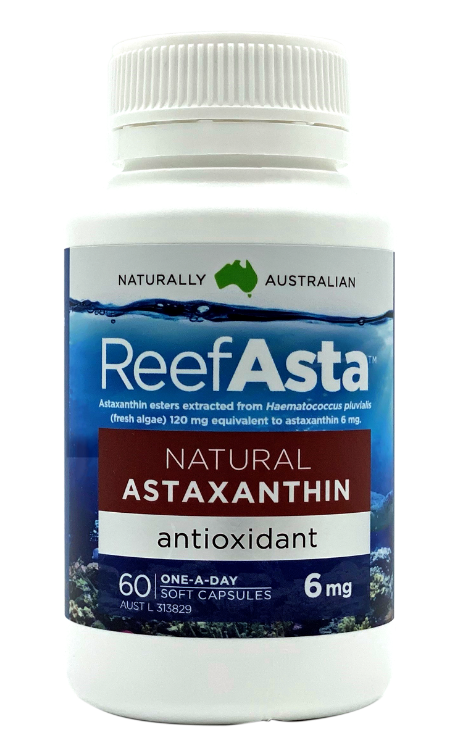Astaxanthin is a red pigment found in a variety of natural organisms. It’s a carotenoid, similar to beta-carotene and lutein which have antioxidant properties and are produced by plants and microalgae as protection from environmental harm such as UV. Due to its unique composition astaxanthin is considerably more antioxidant and protective to cells than other natural carotenoids.
Whilst astaxanthin is found in a range of organisms, it’s most abundant in microalgae. Essentially, astaxanthin acts like a shield to prevent damage to algae in cases where there is environmental stress (water or food scarcity or extreme weather). In Haematococcus pluvialis, astaxanthin production is a survival mechanism that allows the microalgae to survive for over 20 years under conditions that would otherwise be inhospitable.
Astaxanthin is a unique antioxidant as it’s easily absorbed throughout the body where it helps to neutralise free radicals and protect against oxidative stress and inflammation in our organs and skin. Its ability to cross blood-brain and retinal barriers also specifically enables eye and brain protection. The structure of astaxanthin is both water and fat soluble which means it can fit into the span of the cell membrane, providing superior cell protection compared to some other antioxidants.
Extensive research has proven astaxanthin has a range of health benefits, which have also been approved by the Australian Therapeutic Goods Administration (TGA), including:
- Reduces free radicals formed in the body
- Decreases free radical damage to body cells
- Relieves inflammation
- Helps maintain healthy cholesterol
- Supports healthy cardiovascular system function
- Helps enhance physical performance
- Maintains cognitive function
- Maintains skin firmness
- Maintains skin health
- Maintains skin hydration
As it’s fat soluble, astaxanthin can take some time to build up in your body. Most individuals notice the effects in 2-6 weeks, and it’s recommended that you take astaxanthin with food to help increase absorption.
Astaxanthin is commonly consumed in many fish and seafood species. There is considerable scientific evidence, including human and animal research, supporting the safety of astaxanthin*.
To-date we have not received any complaints or reports of side effects from ReefAsta consumers. Despite the scarcity of reports on any side effects of astaxanthin, which has led to its approval as a safe therapeutic compound, there have been few reports that astaxanthin may cause reddening of stools and stomach discomfort. Astaxanthin has been shown to be incompatible with certain pharmaceuticals and herbal treatments and should therefore not be consumed with these compounds without prior consultation with a medical practitioner.
* FDA (2000) Technical Report (Aquaresearch Inc.) Haematococcus Pluvialis and Astaxanthin Safety For Human Consumption. Spiller GA, Dewell A (2003) Safety of an astaxanthin-rich Haematococcus pluvialis algal extract: a randomized clinical trial. J. Med. Food 6:51-56. Stewart JS, Lignell A, Pettersson A, Elfving E, et al. (2008) Safety assessment of astaxanthin-rich microalgae biomass: Acute and subchronic toxicity studies in rats. Food Chem Toxicol 46:3030-6. Okada Y, Ishikura M, Maoka T (2009) Bioavailability of astaxanthin in Haematococcus algal extract: the effects of timing of diet and smoking habits. Biosci Biotechnol Biochem 73:1928-32
We recommend 1 capsule of 6mg per day, taken preferably with lipid-rich foods such as nuts and oils to help increase absorption.
Astaxanthin is one of, if not the, most powerful natural antioxidant safe for human consumption. In contrast to other antioxidants which have specific localised activity (e.g. betacarotene and Vitamin C), astaxanthin sits across entire cell membranes, providing antioxidant and anti-inflammatory properties, within the cells, across cell membranes and cell exterior. Astaxanthin has the unique characteristic that it can cross the blood-brain barrier, and blood-retinal barrier providing its health benefits in the brain and eyes. As astaxanthin is particularly bio-available for uptake by the body it is easily absorbed, available and accumulated in tissues.
Yes, ReefAsta is gluten free.
ReefAsta capsules contain only H. pluvialis astaxanthin oil (extracted using supercritical CO2) and extra virgin olive oil
No, ReefAsta Astaxanthin only contains naturally derived astaxanthin and extra virgin olive oil.
It is important not to confuse natural microalgal astaxanthin found in ReefAsta, with synthetic astaxanthin which is not approved for human consumption.
Astaxanthin is not currently recommended for consumption by children.
In case of excessive astaxanthin consumption and/or an overdose is suspected, please contact your state poisons hotline, your nearest medical facility, or your medical practitioner, immediately.
Always read the label. Always consult a health professional before taking ReefAsta products.
Contains Sulphites.
Due to limited data Astaxanthin is not currently recommended for consumption by pregnant or lactating women.
Astaxanthin should be taken with caution by people with low blood pressure or those who are taking blood pressure medications. Always consult a health professional before taking ReefAsta products.
